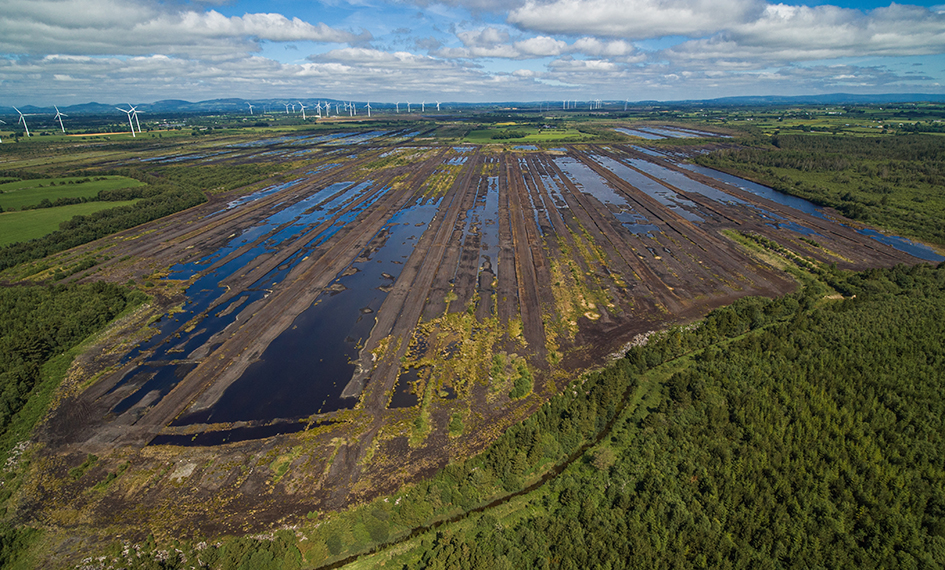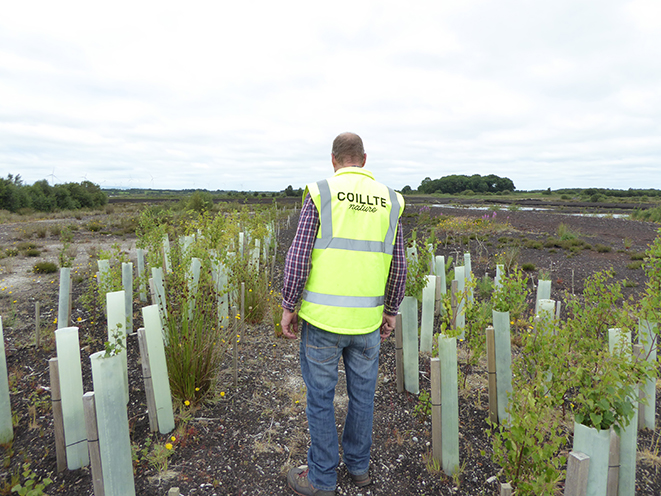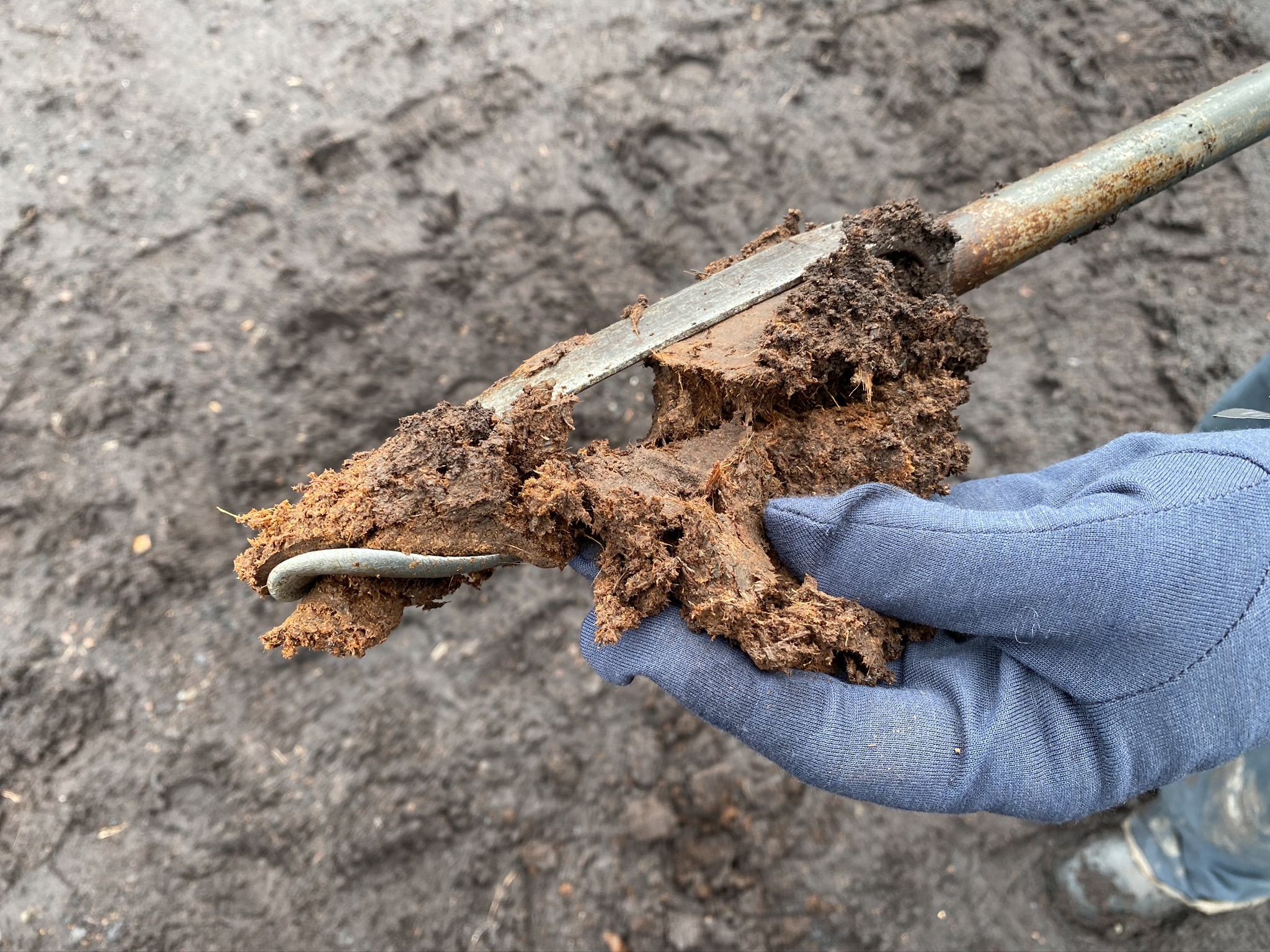MIDLANDS NATIVE WOODLAND
Stay up to date! Subscribe to our newsletter
The raised bogs of the Midlands are some of Ireland’s most important habitats. Formed over millennia by plants decomposing without oxygen, healthy raised bogs provide a home for unique plants and wildlife. They also deliver a range of ecosystem services that benefit people. These include regulating services like carbon sequestration, water filtration and flood mitigation, and cultural services like aesthetic beauty, a sense of awe and wonderful opportunities for spending time in nature.
Historically, however, Ireland’s focus has been on the provisioning services these ecosystems provide – namely, peat. From the mid-1940s, the power of Ireland’s extensive peat resource was harnessed to provide an indigenous fuel source for electricity generation and home heating, as well as peat moss for the horticultural industry. In doing so, it generated significant socio-economic benefits for rural communities across the Midlands region.
But it also led to the rapid and unsustainable exploitation of a finite fossil fuel and – critically – the consequent role-reversal of a large area of land from carbon sink to carbon emitter.
Today, the power of peat is understood in the context of healthy peatlands. There is an urgent need to rehabilitate these sites in order to support the achievement of national and international emissions targets and accelerate the restoration and creation of biodiverse habitats on a very large scale.
| Project Details | |
| What? | Cutaway bog |
| Where? | Co. Kilkenny and Co. Tipperary |
| Why? | To support biodiversity and help to reduce carbon emissions from the bare peat soils |
| How? | Speed up natural regeneration of woodland on dry areas by sowing seeds, planting cuttings and young saplings in areas of the cutaways that can’t be rewetted |
| When? | 2020 – long term |
| Partners? | Bord na Móna |
Native woodlands are a natural part of a peatland ecosystem mosaic, typically found on drier areas above the high watermark on bogs and fens. As Bord na Móna undertakes the process of rewetting much of its exhausted land bank, some of the areas unsuitable for rewetting have been identified as potential sites for native woodland.
WHAT WE’RE DOING
Coillte Nature is working with Bord na Móna at one of their cutaway raised bogs at Littleton, on the border of Co. Kilkenny and Co. Tipperary. By mimicking natural processes, we hope to speed up native woodland development on just over 200 hectares, which is about 5% of the total site.
Native woodlands comprise one aspect of the rehabilitation strategy, while the overarching objective is to re-wet cutaway bogs wherever possible. Areas deemed suitable for native woodland development as part of this project are unsuitable for re-wetting (e.g. mounds, ridges, steep slopes and other raised areas).


Post-industrial cutaway bogs are among the most problematic sites on which to establish trees. Extreme exposure, low biological activity in the peat, high acidity, low nutrient availability and the presence of deep peat present technical challenges that necessitate a steep learning curve in terms of how we get trees to grow.
For this reason, the project team will be led by nature and seek to replicate the succession patterns of the natural woodlands that have already begun to regenerate on or near these cutaway bogs.
Extensive trials (over 100 plots) were established in early 2020 to inform the Environmental Impact Assessment using a mix of native Irish and local-provenance species, including birch, willow, Scots pine, rowan and alder. We tested a range of novel afforestation methodologies, such as seeding, planting bareroot trees, plugs and willow cuttings, with and without fertiliser, under different site preparation treatments, and across a range of peat depths and types. The learning from these trials is ongoing and more will be conducted over the next two years as we explore additional techniques.

The prospect of a potentially transformative solution for these degraded, complex landscapes, however, brings significant hope for emissions reduction, peat stabilisation and biodiversity and recreation enhancement at a landscape scale. However, this is an ambitious and challenging project that requires a cautious, close-to-nature, collaborative and adaptive management approach, and the team is engaging closely with stakeholders from public, academic, practitioner and non-governmental sectors to deliver it.
CONSERVATION DETAILS
The trials for this project are taking place on Bawnmore bog, part of the Littleton Bog Complex, which is located 3 km east of Urlingford on the Tipperary/Kilkenny border. Up until 2017, the majority of Bawnmore was managed for industrial milled peat production and was dominated by bare peat and recolonising vegetation. In 2017, Bord na Móna announced the closure of the Littleton Briquette factory and the cessation of industrial peat production in several cutaway bogs within the Littleton Bog Group, including Bawnmore.
Today the site comprises a mosaic of peatland habitats including both naturally colonised areas as well as some rehabilitated wetlands. These include pioneer poor fen, pioneer purple moor-grass (Molinia caerulea) and birch mosaics, heather-dominated dry heath, a wetland surrounded by bottle sedge-dominated poor fen vegetation, bog cotton and reed beds, and a large area of partially developed high bog with many typical raised bog features still present and a typical raised bog species assemblage, including significant Sphagnum cover (50-75%) in places.
While some small sections of production-related cutaway are already re-vegetating with typical pioneer cutaway habitats, many areas remain unvegetated bare peat. These areas are heterogeneous in terms of their environmental characteristics (e.g. varying topography and peat depths) and although re-wetting is the primary rehabilitation strategy, some of the site will remain relatively dry due to its natural conditions.
Find out project updates on our Coillte Nature News page.
Dublin Mountains Makeover
When the first of Coillte’s Dublin Mountains forests were planted between the 1940 and 1960s, the city was a distant concern, both geographically and in...
Restoring Hazelwood
Hazelwood Forest lies at the heart of Yeats country on the shores of Lough Gill in County Sligo, overlooking the Lake Isle of Innisfree. A...